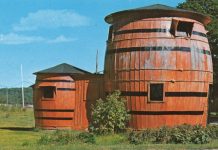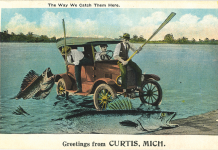Porcupine Mountains Wilderness State Park is located on the shores of Lake Superior in the northwestern reaches of the Upper Peninsula, about 17 miles west of Ontonagon. The “Porkies,” one of the higher land masses between the Black Hills and the Alleghenies, are made up of a series of broken ranges. The rugged and rocky terrain rises to 2,023 feet above sea level, the highest point in Michigan, making it a choice location for skiing.
Today, the Porkies offer excellent slopes for downhill skiing, about 25 miles of cross-country skiing trails, as well as opportunities for snowshoeing and backcountry skiing. And there’s nothing like the spectacular view of Lake Superior from the top of the slopes to make the Porkies an all-time favorite ski experience. But that wasn’t always the case. Despite having ample snowfall in the region, skiing there didn’t begin until the state park was created.
In 1943, the Michigan Conservation Commission presented a proposal to the Michigan Legislature to acquire approximately 46,000 acres of land comprising the Porcupine Mountains in Gogebic and Ontonagon counties. Acquisition by the Department of Conservation, which later became the Department of Natural Resources, began in 1944 and the state park formally was established in 1945. Today, the park consists of about 60,000 acres and is one of the few remaining large wilderness areas in the Midwest with towering virgin timber, secluded lakes, wild rivers and streams, and stunning waterfalls.
The ski hill, dedicated in March 1941, was an instant success. Club membership rocketed to 350 members that first year with an annual
fee of $1 for use of the slope.
Back then, though, there was little history of snow skiing in the area. And while officials from the U.S. Central Ski Association and the U.S. Forest Service had suggested a recreational ski area in the Porcupine Mountains, nothing happened until local businessmen from Ontonagon formed a ski club in October 1940. With 20 charter members, many volunteers and some assistance from the U.S. Forest Service, work was completed on the first ski hill, Weather Horn Peak, a shelter house, 1,100-foot ski tow and three cross-country ski trails.
The ski hill, dedicated in March 1941, was an instant success. Club membership rocketed to 350 members that first year with an annual fee of $1 for use of the slope. Inmates from the local prison were brought in to pack the snow on snowshoes and run the rope tows.

The Department of Conservation took over after World War II and made several improvements, increasing the economic viability of skiing in the park. By January 1950, five new slopes were built, including a beginner’s slope. An intermediate open slope 1,800 feet long with a 350-foot drop was constructed and an intermediate trail 1,900 feet long with a 350-foot drop followed. Two expert ski trails also were built with 585 feet of vertical drop in places. Prison labor from nearby Camp Porcupine, a minimum-security facility, was used for most of the work, including construction of a large warming hut with a concession center, workroom, first aid station and ski shop. The runs were serviced by three rope tows until 1958 when a new state-of-the-art double T-bar lift was installed.
 The Porkies were on their way to becoming a ski destination, as some enthusiasts speculated, a veritable “Sun Valley of the Middle West.”
The Porkies were on their way to becoming a ski destination, as some enthusiasts speculated, a veritable “Sun Valley of the Middle West.”
The Porkies are in the Lake Superior “snowbelt.” Its average annual snowfall is 175-plus inches. A long winter season runs from mid-December through mid-March in most years. The warming shelter was enlarged in the late 1950s with picture windows for viewing the ski area, comfortable seating and fireplaces. Upgrading and improvements to the ski area continued throughout the next several decades. In 1996, the Michigan Department of Natural Resources privatized the ski facilities.
BLUE Vintage Views columnists M. Christine Byron and Thomas R. Wilson reside in Grand Rapids. They are authors of the book “Vintage Views Along Scenic M-22 including Sleeping Bear Dunes.”








Facebook Comments